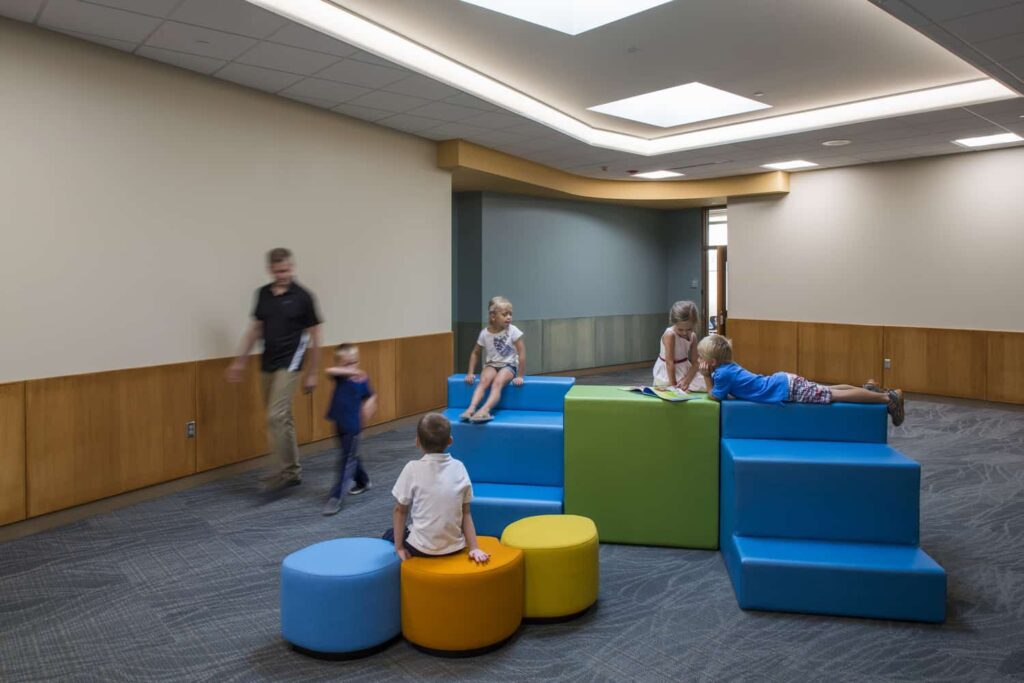The Centers for Disease Control currently estimates that 1 in 68 children in the United States are diagnosed with autism spectrum disorder (ASD). Approximately 1 out of every 128 students aged 6 through 21 for the 2013-2014 school year were diagnosed as having an emotional disturbance in the United States. Additionally, 4.1 percent of Minnesota students aged 6 through 21 with disabilities attended a separate school or residential facility for their special education needs (Minnesota IDEA Part B Profile, 2015).
However, despite the increasing prevalence of these populations, and subsequent increasing demand for dedicated special education facilities, these behavioral and mental disorders are often excluded from design criteria for K-12 facilities.
Karner Blue Education Center is a 70,000-square-foot, one-of-a-kind facility that caters to the specific needs of students with autism spectrum disorder (ASD), emotional behavioral disorder (EBD), and developmental cognitive disability (DCD). While ASD, EBD, and DCD are immensely layered in their complexities, common approaches to curriculum in these educational healing learning facilities revolve around the development of the ability of the student to “self-regulate,” meaning to react calmly to stressful environmental stimuli. For many students with autism spectrum disorder, this may mean something as simple as learning how to respond calmly to the negative sensation of an undesirable furniture fabric.
As a member of the University of Minnesota’s School of Architecture’s Consortium for Research Practices, BWBR engaged in a 6-month research project at Karner Blue Education Center to build a deeper understanding of how the built environment can positively impact the mental, educational, and behavioral well-being of this student population. By leveraging the robust connections between practice and academia, the Consortium aims to close the knowledge loop among academic researchers and professional practitioners in the architectural and design fields. This is accomplished through semester or year-long research internships, in which Master of Architecture students are paired with a local firm with compatible research interests.
Borrowing features from mental health, behavioral health, and secure environments, this emerging building typology — the healing learning environment — is capable of providing opportunities to study the post-occupancy effectiveness of design decisions implemented specifically for these students with special needs.
To explore how the building’s unique features impact the students, particularly during emotionally or behaviorally trying times throughout a day, 64 hours of immersive observations were captured to provide insight into how the building is acting as a tool in helping students remain calm throughout their often chaotic daily lives. Additionally, a survey was administered to Karner Blue staff inquiring about their understanding of how staff encourage students to use the building during moments of escalation.
Findings of the observations suggest the frequent use of secondary spaces such as classroom “breakout rooms,” sensory rooms, community pods, and swing rooms may reduce the amount of disruption to others in the classroom and help students de-escalate in privacy. Additionally, in the first two years since the opening of Karner Blue Education Center, the staff have seen a 75-percent reduction in the number of cases requiring a staff member to seclude a student acting in an injurious manner towards others.
Future designs of similar types of buildings can learn from this study by incorporating a variety of secondary spaces that are easily accessible to the student. Spaces should provide different types of stimuli input such as spaces for gross motor skill development, sensory rooms with calming lighting and soft furniture, or a room that provides a swing specifically designed to cradle students with sensory needs such as those with ASD.
The importance of studying unique and experimental features of architectural spaces has proven critically important to the advancement of not only the field of architectural design and research, but also to the field of behavioral and mental health. In conducting research of this type, BWBR and other design firms belonging to the Consortium for Research Practices are making headway on providing evidence-based and empirically-studied design that truly makes a difference in the daily lives of these unique student populations.
Kathleen Bond is a master’s candidate in architecture at the University of Minnesota’s School of Architecture and is an architectural student intern at BWBR.








